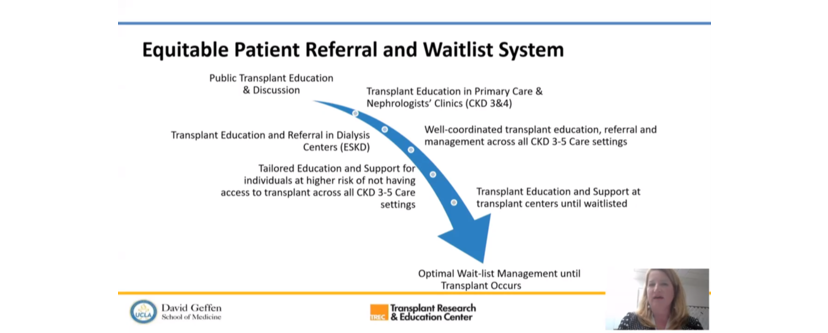By Erica Ho, Senior Research & Education Associate
April 16, 2021
On Friday April 16, Dr. Amy Waterman spoke at the National Academies of Science, Engineering, and Medicine’s virtual public webinar, “A Fairer and More Equitable, Cost-Effective, and Transparent System of Donor Organ Procurement, Allocation, and Distribution”. This webinar was held to educate the public on two important aspects of the current state of deceased donor organ transplantation in the country. The morning session comprised of medical leaders from around the world sharing their own countries’ experiences with navigating fair and timely organ transplantation processes. Learning about these different approaches from other countries will undoubtedly help the United States devise new policies and methods to improve its own organ procurement and distribution systems. Dr. Waterman was a guest speaker in the second half of the webinar as part of a panel of experts in identifying and mitigating inequalities patients face during the referral, evaluation, and waitlisting stages of their deceased donor organ transplant journey.
Dr. Waterman’s talk, “Working Toward a More Equitable Patient Referral and Waitlist System for Kidney Transplantation”, highlights current issues in deceased donor kidney transplant (DDKT), such as the geographic, racial and ethnic, linguistic, and income disparities that inhibit kidney patients from reaching the necessary milestones in order to receive a life-saving kidney transplant. In her presentation, Dr. Waterman provided several examples of how her own research has successfully identified various disparities in kidney transplant accessibility. The Kidney Transplant Derailers Index (KTDI) measures socioeconomic challenges kidney patients face that may hinder their ability to get on the waitlist and ultimately receive a transplant1. These derailers include level of health insurance, employment, financial insecurity, educational attainment, perception of neighborhood safety, access to a vehicle, having a washer and dryer, and quality of social support. This study found that patients with a higher KTDI score, indicating significant socioeconomic barriers in their lives, had a reduced probability of getting waitlisted and took longer to get on the waitlist.
In addition to identifying barriers, Dr. Waterman also showcased her work in solving them. She emphasized the importance of recognizing that barriers exist at every level of the healthcare system, not just the patient-level. Therefore, several mitigation strategies must be combined to tackle the various disparities throughout the system. One of the most powerful ways to address these multi-level barriers is through education reform. To demonstrate the cruciality of education to improve kidney patient health outcomes, she shares results more studies, including “Your Path to Transplant: A randomized controlled trial of a tailored expert system intervention to increase knowledge, attitudes, and pursuit of kidney transplant”. This study tested the effectiveness of Your Path to Transplant, an individually tailored modular education program, at helping patients get waitlisted and pursue kidney transplant. This study found that patients who received Your Path to Transplant education had increased transplant knowledge and readiness to pursue transplant, indicating that specialized and targeted education is successful in improving patients’ ability to get a kidney transplant2.
There are more ways to reduce the barriers patients face in their pursuit of transplant, such as reducing financial disincentives, managing waitlist dropouts, and destigmatizing high-risk kidneys. Storytelling is another way to support providers in their education efforts and patients in making empowered and informed choices. Storytelling can be a cost-effective and convenient way to encourage patients and the general public to learn about kidney transplant3. Unlike traditional education, which may be delivered in an impersonal, rushed, and clinical manner by a healthcare provider, stories are created by people who the patient can relate better to, thus providing patients with more emotional support to pursue their own transplant journey.
Dr. Waterman concluded her talk by emphasizing the need for a cohesive collaboration of all layers of the healthcare system in order to provide the best experience and outcomes for patients. Methods to standardize transplant metrics, normalize positive and open conversation about transplant, training providers to learn more about transplant themselves, and creating health literate and culturally appropriate education tools are areas of research the Transplant Research and Education Center continues to investigate, and encourages others in the transplant field to explore as well.
- Peipert JD, Beaumont JL, Robbins ML, et al. Development and Validation of a Socioeconomic Kidney Transplant Derailers Index. Transplant Direct. 2019;5(11):e497.
- Waterman AD, Peipert JD, Cui Y, et al. Your Path to Transplant: A randomized controlled trial of a tailored expert system intervention to increase knowledge, attitudes, and pursuit of kidney transplant. American Journal of Transplantation. 2020;n/a(n/a).
- Waterman AD WE, Ranasinghe ON, Faye Lipsey A, Anderson C, Balliet W, Holland-Carter L, Maurer S, Aurora Posadas Salas M. A Digital Library for Increasing Awareness About Living Donor Kidney Transplants: Formative Study. JMIR Form Res. 2020;4(7):e17441.

